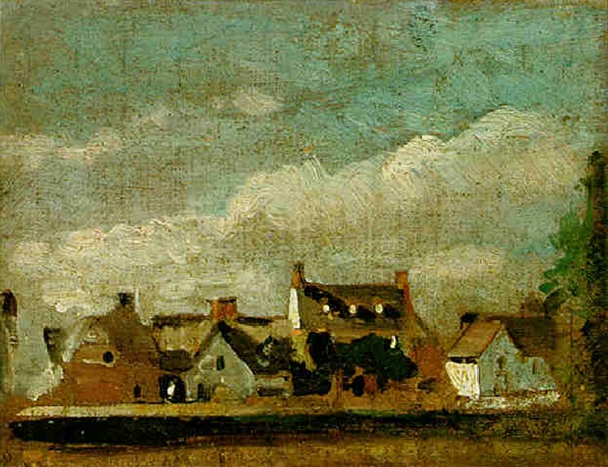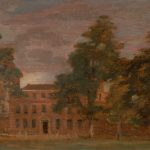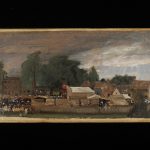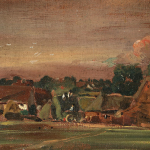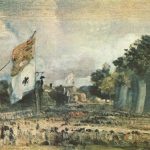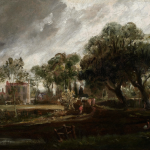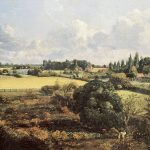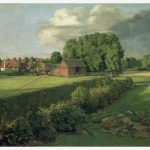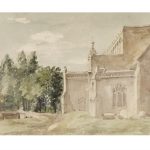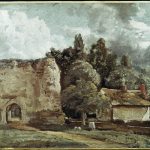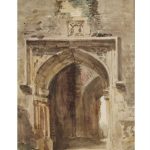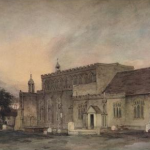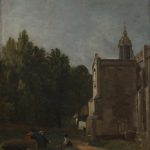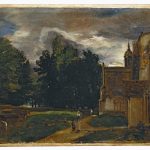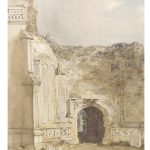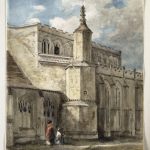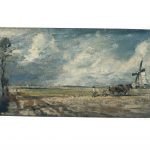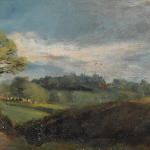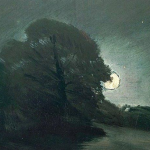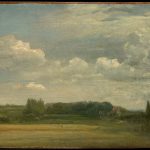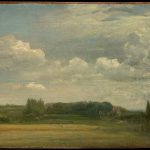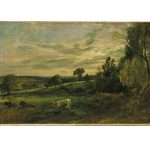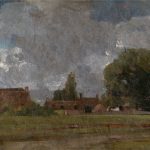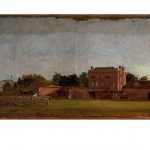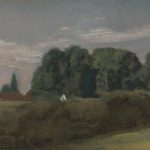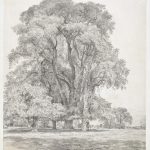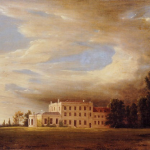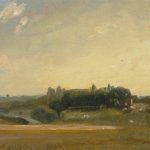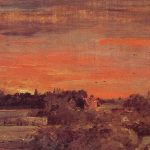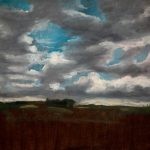Painted from the grounds of East Bergholt House circa 1811, Beaufort Cottage stands at the edge of the old Village Green and has close links to both 'A Village Fair' and 'Flatford Mill' painted in the same year.
Initially titled 'Wooley Hall' this sketch shows the magnificent frontage of West Lodge as seen from Constable's family home, East Bergholt House.
Constable painted many elevated views from the upper levels of East Bergholt House, his childhood home, including this ‘Village Fair’ painted in 1811.
A rare sketch of East Bergholt done in the late evening of 10 August depicting the back of East Bergholt House, home of the artist's father Golding Constable, showing the grain store.
A view from The Street towards the home Golding Constable built for his family in the heart of the village 'East Bergholt House'
Landscape depicts the view from Constable's parental house in Suffolk in 1815, painted from an upper window or the roof of Golding Constable's house.
It depicts the kitchen garden belonging to the artist's father, looking over the fields in the centre of the village.
Landscape depicts the view from Constable's parental house in Suffolk in 1815, painted from an upper window or the roof of Golding Constable's house. It depicts the Flower Garden as a panorama, moving from the village at the left of the flower garden to the refectory and houses at the right of the kitchen garden.
A watercolour showing East Bergholt Church from the east under a sunny sky with a few small clouds. A group of trees stands in the distance on the left and it is inscribed on the back in pencil by the artist June 1806.
Although the exact year is unknown, this sketch depicts the ruined tower at the West end of St Mary's Church, East Bergholt.
This watercolour of the south archway of the ruined tower was painted during Constable’s visit to East Bergholt in June 1806 prior to his 2 month trip to Windemere and is the only watercolour from this visit with a precise date.
East Bergholt Church, from the south side and clearly showing a doorway and porch to almost the centre of the sketch that no longer exists.
This is believed to be the first oil painting that Constable exhibited, A Church Porch, which Constable sent to the British Institute in 1811, noting: The ‘Porch’ is that of Bergholt Church, and the stillness of a summer afternoon is broken only by the voice of an old man, to whom a woman and a girl sitting on one of the tombs are listening.
With the moon rising, or the sun setting behind the porch, three figures walk on the path leading to the porch.
The canvas has been relined at an unknown date and the new stretcher inscribed ‘Church Porch evening’.
Images of ruins were a recurrent theme in Romantic art and literature and therefore can be difficult to date given the manner of use of watercolour. Inscribed on the back in pencil 'East Bergholt Church' it is believed this was painted between 1805-1811 as when compared to the earlier work 'East Bergholt Church' C1805, the medium is handled with less freedom and confidence.
Constable's compositions were always based on the nature of English landscape or rural pastures. He used symmetrical compositions and scenes that focused on manmade buildings such as a mill, cottage, or in this case a church and although little is known about this sketch or the exact year it was completed, it is inscribed on the back – J Constable R.A. EB Church serial number ‘20’
The landscape shows two horses and the windmill on the heath at 'Windmill Bank', owned by Golding Constable, the artist's father. This is where Constable had worked after school, teaching him to study the skies to predict the wind conditions and trim the sales appropriately. This proved invaluable when it came to capturing the skies in these Suffolk paintings for which he became famous in adult life.
The first in the group of Constable's views towards the Rectory as seen from the grounds at East Bergholt House, from where the ground slopes down towards the Ryber Valley, and which is said to have had personal significance to Constable as it was painted during his long courtship with Maria Bicknell.
Constable admitted himself to having a ‘vanguard’ style of work using broad brushstrokes, at the time frowned upon by The Royal Academy. However this technique went on to be developed by the Impressionists of the late 19th | early 20th centuries.
Believed to have been painted in the summer of 1813 from an upper window of East Bergholt House. The view is towards the Rectory which is concealed by trees but bathed in light from the bright summer's day.
Believed to have been painted in the summer of this year from an upper window of East Bergholt House, the Rectory concealed by trees is bathed in light from the bright summer’s day.
Summer Evening, a view near East Bergholt showing Langham Church, Stratford Church and Stoke by Nayland Church, painted from the grounds of West Lodge (now Stour), the home of Constable's dear friend and elderly neighbour Mrs Sarah Roberts.
The stand of trees and the lone poplar tree on the right make it clear that this view is that of the rear of East Bergholt House, the property built by Golding Constable in 1774, the artist's family home.
A panoramic view of Constable’s family home, East Bergholt House, built by John's father, Golding Constable, in the late 1700’s and where the family lived until 1819. After selling it to a family friend it fell into disrepair and was demolished c1840
Constable was deeply attached to his birthplace, East Bergholt House, which his father had built when Flatford Mill became too small for his growing family. Although the house was pulled down c1840, the stable block and outbuildings survive
Old Hall, East Bergholt,
pencil with slight grey and white washes, 1817, Victoria and Albert Museum
A magnificent example of Constable's earlier work, commissioned by John Reade, Lord of Old Hall Manor from 1801
Having sketched this exact view the previous evening ‘East Bergholt Common towards the Rectory’ 1813, Constable painted this at sunrise the 19th August of this year.
Constable painted several oil sketches of the view towards East Bergholt Rectory, over the fields that he loved.
Clouds over the Rectory, a view from East Bergholt House, family home of the Constable family.

